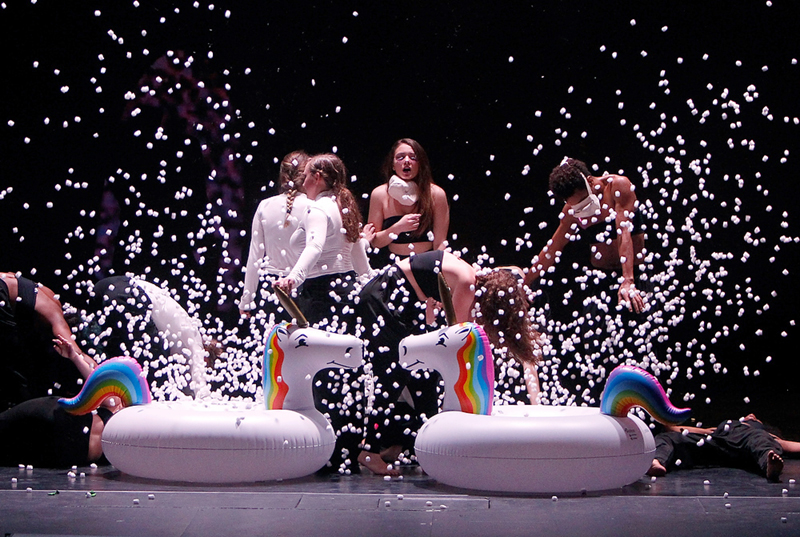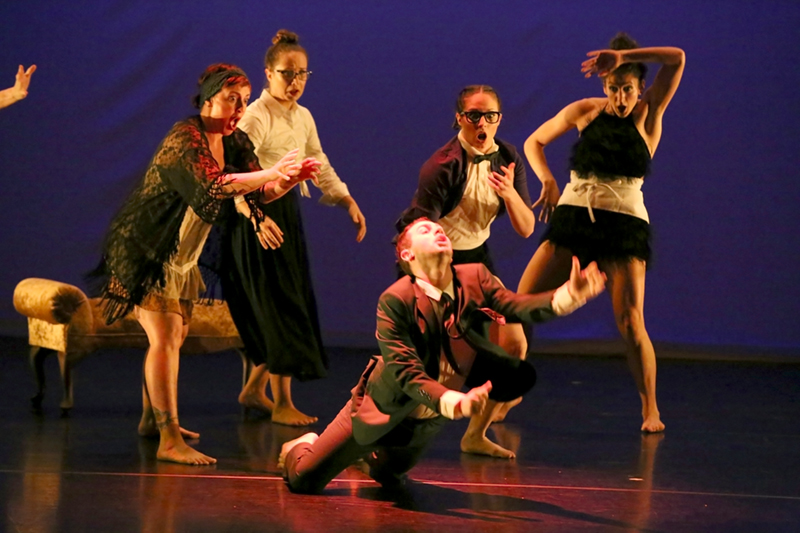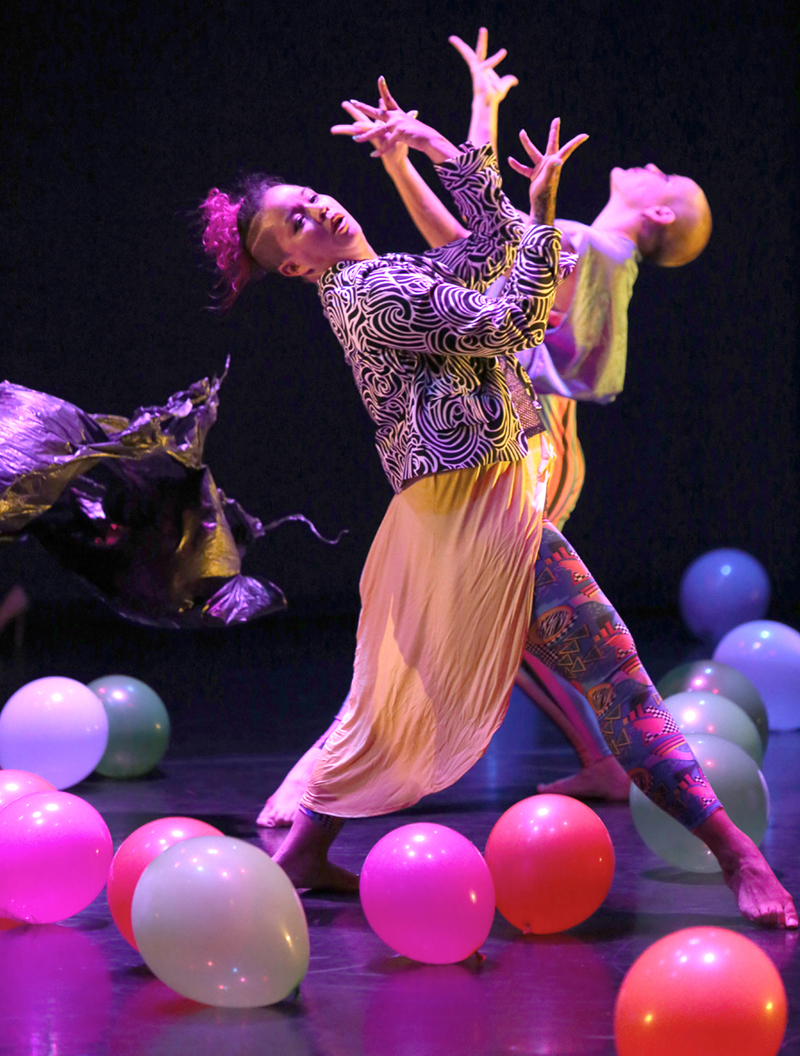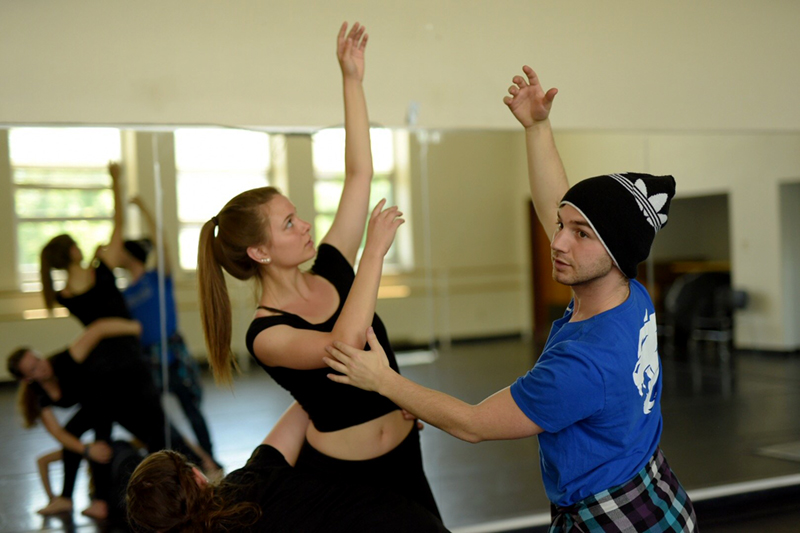On Mess, Failure and Queer Expression
An Interview with Anthony Alterio
BY EMMALY WIEDERHOLT
Anthony Alterio is a choreographer and assistant professor of dance at State University of New York (SUNY) at Fredonia. His work explores representations of effeminate gay men in pop culture. He is also co-director of a summer dance intensive geared toward the LGBTQIA+ community called Excessive Realness. Here, he shares his choreographic and teaching philosophy as well as why he co-founded Excessive Realness.
From FEEDBAG, set on students at the University of Kentucky
~~
Can you tell me a little about your dance history – what kinds of performance practices and in what contexts have shaped who you are today?
I started dancing at the age of nine in a boy’s class at a dance studio called Dance Etc., which was located outside of Pittsburgh. The class was half tap and half jazz. I loved it and begged my mom to let me quit soccer, which I had been doing for about four years. She wouldn’t and asked that I stick with it, so one day I laid down in the field at a soccer game out of protest. After that incident, she ended up letting me quit soccer and, from that moment on, I was immersed in the studio competition world. I studied musical theater, tap, ballet, hip-hop, acro and jazz.
I’m on the short end for a male dancer and, in the competition world, I was expected to pair with females and lift them. Instead, I wanted to be lifted and partner with the other boys, but this was not really accepted in competition dance around the early 2000s. I increasingly felt a sense of distance and disconnect from the expectations around me as I grew into my sexuality as a gay man. I also was being a little rebellious at the time; I started piercing my ears and dying my hair. In the competition world in the early 2000s, this was unacceptable, and these behaviors were unwelcomed because you had to look a certain way and personify a certain image. I actually ended up quitting dance at age 15 because I felt rejected from my own community.
I ended up going to the University of Colorado at Boulder when I was 19 to study psychology, but my advisor at the college urged me to take electives that I was interested in. At the time I was only really dancing at concerts, raves, block parties and social events, but figured what the hell. So, I ended up taking a dance class from Michelle Ellsworth, who still teaches in the department today and whose career has taken off into legendary status. She asked me why I wasn’t a dance major and encouraged me to audition. I ended up trying out, but sadly didn’t get in. Michelle for some reason wasn’t at the audition so, when I saw her next, I told her I wasn’t accepted and how dance had turned its back on me when I was younger. What she did next changed the course of my life. Michelle set up a special meeting with me and the whole dance faculty, that mind you had just rejected me from the major, and she asked me to just freestyle improv for two minutes. I then waited in the hall patiently, which felt like a lifetime but probably was only five minutes. They called me back in and told me that I could be a dance major. I am forever grateful to Michelle for believing in me and seeing something I couldn’t even see in myself.
From then on, my focus shifted from Psychology to Dance. My stepdad owned a hardware store, so I grew up around a lot of tools. I started incorporating that interest of making things into my choreography. I also got the privilege to study and work with Rennie Harris, Larry Southhall, Erika Randall and Onye Ozuzu for four years. Growing up in Pittsburgh, I would go to block parties and clubs with my sister in the South Side. I loved house movement, block parties, concerts, any environment with social dance; it was my release from the competition stuff, which felt at the time so produced and overworked. When I would go to parties and clubs, it felt like an amazing environment because everyone was free and just dancing how they wanted. I loved finding that again with Rennie, Larry, Erika and Onye in my undergrad career.
Erika Randall, who is now the department chair at University of Colorado Boulder, was also a huge influence on me. I will never forget when she told me I needed to be gayer and more queer in my work. I was always told at the dance studios to be more masculine, more male, and more toned. Erika helped my fabulous, queer, flamboyant sides flourish, which had been repressed from years before.
Photo by Wendy Turner, from Interweave Dance Theatre
Amazingly, I got hired right out of undergrad at the university because I had also worked as an assistant technical director throughout undergrad. It was a great opportunity to focus on the technical aspects of choreography like projection, lighting, stage managing, video projection, and prop design. It really helped me to meld my two interests of dance and design into one. I did that for a year and then decided to go to grad school.
I ended up at the University of Michigan where I met Clare Croft, an amazing queer scholar. She became my biggest advocate while I was at U of M. I also received wonderful mentorship from Amy Chavasse, Robin Wilson, and Jessica Fogel. I loved diving into queer work during grad school and got the chance to work with two of my idols while doing research in the summers, Darrell Jones and Teena Marie Custer.
Right after grad school, I got a job at University of Kentucky as a lecturer in dance. I was there for three years. As of August 2019, I am at SUNY (State University of New York) at Fredonia in a tenure-track job, and I’m only 30. It still feels unbelievable at times. To be honest, my whole road to get here was people telling me to drop out, that I was never going to make it. I thank my mentors who kept pushing me.
How would you describe your choreography to someone unfamiliar with it?
Props, queer, electric, mess and failure. I do a few solos, but mostly love choreographing group work. I also love choreographing on students and then touring the work with them. I never was interested in owning my own company, so this is a great alternative. In my work, there is always a theme of playing on some type of nostalgia. I often incorporate popular culture and subcultures. This makes it relatable to the audience, while also being able to bring new information or see information in a way they hadn’t noticed or thought about before.
I’d say 70 percent of my work is choreographed and 30 percent is left to mess and failure, which I always have an element of in my choreography. It keeps the performers on their toes when it’s not the same material every night. And it’s exciting as a choreographer because it allows the piece to grow and evolve.
Are there certain themes or issues you feel are particularly important to you to keep tackling and addressing in your choreography?
Without a doubt, gender nonconforming issues, queer theory themes, excessiveness of lifestyles, as well as deconstructing popular culture and examining subcultures within socially acceptable norms. I really enjoy pushing limits of what I think the audience or performers expect in my works.
Photo by Wendy Turner, from Interweave Dance Theatre
How would you describe your teaching philosophy and dance classes to someone unfamiliar with them?
My teaching philosophy is changing at the moment. It truly makes me sad because I love teaching, but I would be lying if I didn’t say that I am currently getting burnt out a little. I am noticing with my current students and their generation that they’ve had technology such as the internet and smart phones for their entire lives. They’ve had access to things they want to buy online or can get ahold of someone immediately. And because of this instant gratification, it seems as if some do not care to turn away from their phones and learn etiquette towards their teachers to truly focus on dance. It feels as if most students want things handed to them instantly without any work. They expect a gold star, a shout out in class, and special attention, which goes along with the thought process of everyone gets a participation trophy. Some students don’t seem to understand that just because you’re doing the movement does not mean you are doing it correctly, it’s not enough. It’s a start for sure but there must be embodiment, style, and character. I don’t see progression and growth no matter how hard I try to instill value, ethics, professionalism, mess, failure, risk, play, or awareness in my classes. It’s like there’s a disconnect. And to be truthful, I am fine with this logic of treating everyone equal and making dance more accessible and open, which has been a part of my pedagogy for years, but the humility and gratitude of learning and passing on dance and the process of transferring knowledge of it has disappeared. This is why my teaching philosophy is up in the air right now. I am working through it though.
Nonetheless, the two biggest aspects of my teaching philosophy are failure and mess. I tell my students: I can teach you technique all day long, but I can’t teach who you are or how you want to be. I can help you get there, spark curiosity, and inspire, but you must decide what you want to emit and put out into the work. It’s hard for them because it forces them to look inward and be vulnerable. On some level, we all must fail in order to succeed in our goals.
I teach mostly what I call commercial dance, lyrical contemporary modern, 90s jazz, a little house, a little waacking, a little voguing. What I love about most about the forms I teach is they are centered around call and response. I have my students repeat mine or someone else’s move, and they might fail in the moment, but then they go home and work on it, just like I did when I would go to block parties in Pittsburgh. I did not have an iPhone to film movement and then learn from it. I try to teach as much history as I can of those forms and encourage dancers to go into the circle and improvise. That’s hard for a lot of students. Students often want to be told exactly what to do in class. Not all of course, but many of them don’t want to do the work. They just want the result. Dance isn’t like Amazon Prime. You can’t get it in two days. It takes time, patience and practice. Our bodies change by the minute, and I always tell my students: Meet yourself where you are today, where you are in the moment. It is just a moment, and you can learn from any moment. It’s all fuel and knowledge. That constant flux is what excites me as an academic and dancer. If you become open to the moments, I believe this is how to succeed as a dancer.
How has your choreography and teaching influenced one another?
I cater to whomever is in the room. Everyone has various bodies, and everybody is different in personality. I like to work with people who are interested in learning, evolving, and changing to learn more about themselves through movement and art. Those choreographic philosophies have influenced me in my teaching to try to make new material and warmups every semester and class based on who is in the room. Since my choreography is very collaborative, my classes have become so as well. I always ask the performers: How does this section of choreography feel? We edit based on their responses. I ask in my classes too: What did you learn from that exercise? How is your body responding? It makes my choreography and teaching stronger because it’s a more connective process between the performer and work or student and class, rather than just setting work on the performers or just giving class to students.
As both a teacher and choreographer, what are some shifts (if any) you’ve seen or experienced with regards to queer access and representation in the dance field?
Queerness is a thriving topic right now. People are curious about queerness in a way I never experienced when I was growing up. I love that it’s more accepted and presented now. I believe technology, social media, and queerness being more visible have been the biggest reasons for more representation, but there were always queer people everywhere.
I had some badass female mentors over the years, but I always thought I’d have a gay male mentor. I didn’t until I met Wade Madsen in 2012, which was another pivotal moment in my life. When I danced at the competition studio, I was taught by a straight married couple. In undergrad, the only gay male professor hated me because I was short, unmuscular, and unmasculine. Even though he himself was queer, his work was heteronormative. Even in grad school, there was one gay male professor who danced with Martha Graham, but his work was very heterosexual. Here I was making flamboyant work, wearing heels and lipstick. I even made a pig that farts confetti. How gay is that?
Photo by Wendy Turner, from Interweave Dance Theatre
Then I met Wade in a company I perform with, Interweave Dance Theatre. We meet as a collective in the summers and are the resident company of the Boulder Jazz Dance Workshop. He ended up becoming a mentor and a really great friend. I’ve been in four of his pieces, I’ve taught class at Cornish for him, I’ve had stupid conversations, serious conversations, and I cannot thank him enough for all the advice and encouragement to keep going. He told me I just have to keep going. I did, and truly it’s paid off. I’m so happy now to see queerness celebrated in academia and queer work presented at national theaters. I know we still have a long way to go as a community to get more representation, but I am truly hopeful. I also hope I can help others in the way Wade has helped me over the years.
Thinking specifically about your students, have you seen shifts in terms of open-mindedness about queer expression?
Yes and no. It depends on where you are geographically. When I was at University of Michigan, even though the campus wasn’t very diverse, they knew what queer theory was. I had no idea what queer theory was in undergrad. When I was at the University of Kentucky, it was a very diverse campus but also very religious. Coming to SUNY Fredonia, I have to say it’s the least diverse campus I’ve ever worked at. Open-mindedness, or at least what I have observed in academia as a white cis gendered male, depends on what students have access to in life, on campus, and what they see performance-wise and resource-wise, not just technology-wise.
When I choreograph on students, they’re always like, “We have never done a piece like this.” Which to them I usually respond, well then you haven’t seen much. I save my out-there stuff for my professional career and my tamer stuff for my academic career because I had a dance piece pulled out of a concert at a university which featured a 6’4” femme boy in a Fifth Element costume being confident and sexy. I also in the past have not been allowed to take work to the American College Dance Association conference because I’ve been told it’s not modern enough or didn’t represent the major. Often, it’s not the students who aren’t open-minded, although of course there are always a few, but more the systems in place or people in charge. I’ve unfortunately had a lot of censorship of my queer work in academia and professionally, but I keep going.
What’s next? What are you working/focused on now?
Excessive Realness is my big project, hopefully for years to come. It was born because my friend Allison Blakeney and I had gone to summer dance intensives like the American Dance Festival, Bates Dance Festival and Salt Dance Fest, and were noticing that half the guest artists were queer, but they weren’t talking about queerness in their classes or choreography, or even making queer bodies feel welcome. We asked ourselves: “Where’s the representation?” I was telling Erika Randall about this, and she said, “Why don’t you start your own queer dance intensive?” I had no idea how to do that, to which she suggested to get a friend and do it together. I then reached out to Allison. They said, “Let’s do it!” and it has been a journey ever since.
We started Excessive Realness in 2018 in Lexington, Kentucky. We were small and brought in four guest artists in addition to us. There were only 12 participants. The feedback from the intensive was great. We ended up talking about how queer people are obviously everywhere. Summer 2019, we moved Excessive Realness to Boulder because of a partnership that had formed with the University of Colorado Boulder. We doubled our participants, added a day to the intensive, and brought in two additional guest artists. This summer, 2020, we’re partnering with Dance Place in DC. We’re going to bring in six artists and it will be a week long. We’re planning some special events in addition to the normal programming.
We totally rely on our grassroots fundraising to make the intensive happen. If you wish to donate or know someone who would be interested in contributing to Excessive Realness, CLICK HERE!
My passion project is the Alterio Motives Award, an award/scholarship I started to help LGBTQIA+ dance major students at the University of Colorado Boulder. So far, we have raised $15,000. If we raise $10,000 more to make $25,000, the award/scholarship becomes a permeant endowment that could help LGBTQIA+ dance major students for generations. Check out this article to learn more. And if you would like to donate or know someone who would be interested in contributing to the Alterio Motives Award, here is the link.
Otherwise, right now my focus is my tenure track life. I have an idea for a project called Conversations With My Straight Boyfriends, but it needs funding, and I would like to start a website and write a book for the project, which take time. I would like to advance my career but I’m not sure how to get to the next level professionally. How does one get a Bessie Award, or get on the Top 25 to Watch, or perform work at New York Live Arts? I don’t know how to get seen, but I am trying. I do worry sometimes because I have seen so many people get into academia who have so much to offer, and then the bureaucracy of the system destroys them. But I just continue and strive to make work and teach. That’s all I can do.
Working with students at the University of Kentucky
~~
To learn more about Anthony’s work, visit anthonyalterio.com.
To learn more about Excessive Realness, visit excessiverealness.com.





